Research - (2021) Volume 0, Issue 0
Do ecological factors dictate the longevity of human life? A case of Asian countries
R. Fatima1, N. Arshed1* and U. Hanif2Abstract
It is believed that human expected life is defined by the environment in which he is raised and his activities. Before the industrial revolution, the environment was considered an insignificant factor as it was the same for all. However, recent deterioration in environmental quality has defined the differences in expected life in different regions of the world. This study aims to investigate the impact of ecological factors such as temperature, ecological footprint, and CO2 and other factors such as GDP, mortality rate and globalization on life expectancy. This study has selected 25 Asian countries to estimate the panel FMOLS model with a moderator from 1994 to 2017. The results revealed that ecological factors, including economic growth, reduce life expectancy. At the same time, globalization shows a positive impact on the life expectancy rate of these countries. The study recommends that despite having tremendous achievements and developments in Asian economies, they still face a high risk from climatic issues. Therefore, the governing bodies of these Asian countries have to develop sustainable initiatives that can overcome with the changes in the climate and make the environment healthy.
Keywords
Environmental Kuznets curve, Economic activity.
Introduction
Health and life are positively correlated with each other. Having good health increases the probability for a long life of human beings and vice versa. Thus, we must have to take an absolute measure to assess the health standard of the country. This measure should help policy makers formulate controls to improve standard of living.
Environmental factors play a vital role in lifelong longevity. The study covers an analysis of the data for developed countries that spend a substantial amount of budget to reduce carbon footprint to protect the environment. Comparatively, people are more sensitive and keen to protect the planet in developed countries than those living in underdeveloped countries. For example, in developed countries, environmental groups or green groups run campaigns if needed. They exert pressure on the governing bodies to take appropriate measures to reduce carbon footprint in order to protect the ozone layer, which has been under significant threat since the evolution of the industrial world.
Consequently, life expectancy indicators are performing much better in developed countries due to these practical steps. Although the comparison of the early and modern life of a human is a bit subjective, the historical data show that the life span of a modern human has decreased with time. One of the great causes of concern is global warming. This means that it is almost impossible to revert to conditions like how it was 100 billion years ago. For example, the allocation of resources can help reduce the carbon footprint, but eradicating the eradication of carbon footprint for one country is like a dream having seen in daylight.
Fig. 1 shows how climate changes affect human health. According to this, the increasing temperature levels that produce heat waves are due to the rise in the industrial sector. As a result, it gives rise to different health-related problems such as dehydration, heat strokes, and respiratory issues.
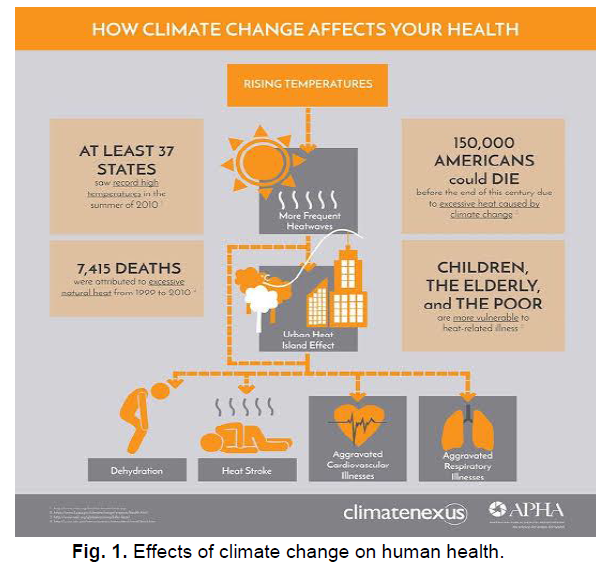
Fig 1. Effects of climate change on human health.
The general health of the population of a country shall be determined by how many people are older than the average age. In some countries, people have a longer life span, meaning they have a higher percentage of older people who are possessive and concerned with the environment and are willing to invest more for future generations. Consequently, life expectancy and factors of sustainable development are positively correlated. To help countries and governing bodies track or measure one country’s performance in relation to the benchmark, EPI (environmental performance index) has introduced different categories, which are divided as, air pollution, energy and climate, quality of air water and sanitation, heavy metals, fisheries, biodiversity and habitat, forests, agriculture and water resources under two planning goals such as environmental health and ecosystem vitality. For conclusive results, the scoring system has been introduced for this scheme. Every indicator shall be assessed and marked from 0 to 100, where 0 indicates the worst and 100 indicates the best performance. For the countries under observation, having a good score represents their commitment towards a sustainable environment.
In order to be effective regarding controlling and mitigating the hazardous effects on the health of human beings due to climate change, there is a need to have objective evidence, and decision makers can outline domestic and foreign policies by using these data. For this case, policymakers would certainly need hard data covering health effects and their size of impact as a whole. This study aims to generate the consequential effects of climate change on lifelong longevity.
Climate is a broader term that needs to be reduced to its attributes or characteristics for a specific time period. These important features are air pressure, temperature, cloudiness and wind, humidity, and sunshine. The living creature shall adapt to the climate of an area to survive. However, in order to adapt the climate, habitats in a particular area will have to be ready for opportunities and threats posed to an environment. The continuous variation in climate will have a disastrous effect on life, as everyone cannot keep pace with the rapid changes in climate. One of many components of climate is that temperature started rising since the beginning of the industrial era (Ekpo, 2014).
Fig. 2 shows the temperature level of different years starting from 1880 to 2020, which four different international science institutions conducted. They concluded that the past few decades show an increase in the level of temperature, and the last decade, 2010-2020, has been the warmest on record. If the temperature keeps increasing with this level, it might affect the most crucial resource availability, i.e. water (Arshed et al., 2020).
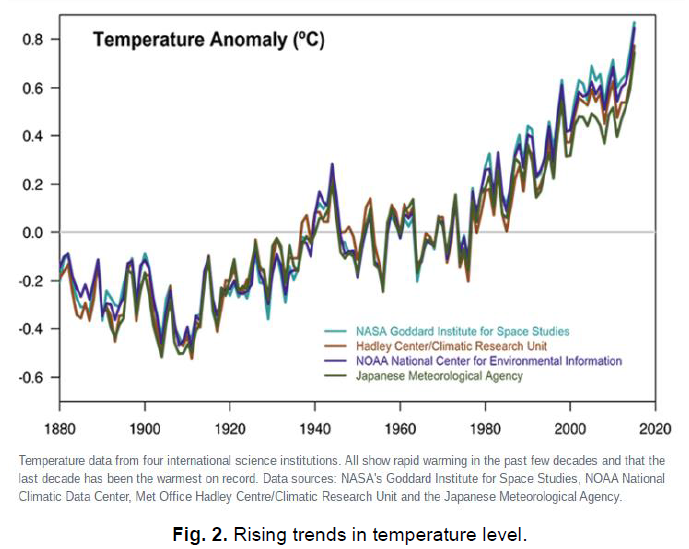
Fig 2. Rising trends in temperature level.
In contemporary times, the rapid increase in human life year expectancy on account of improvements in health expenditure and economic growth has now become a condemnatory debate in the studies of population, as it is conditionally dependent on the economic condition and stability of a country. According to the World Bank report (1998), per capita income is strongly associated with life longevity. Moreover, almost all developed and underdeveloped economies strive to improve the health conditions of their people, and they make efforts to increase life expectancy and reduce mortality rate (King and Girosi, 2007). The wealthy country is expected to have more resources to target life expectancy.
However, the evidence through several studies recommends that personal wellbeing and the rising levels of income are contrarily linked with each other. Ruhm (2000) observed that pursuing economic growth actually kills people. In his work, he finds that people tend to live longer when the economy of a nation falters.
Global warming is known as the rise in temperature of the Earth due to natural phenomena and ventures that emit green gases. These green gases emitted from human activities block heat from reaching the outside (radiating) from the earth into space. Consequently, such gases are known as greenhouse gases because these gases cause one blanket over the globe. Thus, heat cannot pass through, which causes a rise in sea level, erosion, and melting of ice. This study has focused on the ecological footprint to quantify the contribution of size of the impact of a person, organization, or community on the atmosphere and analyzed cost and benefits of it. The ecological footprint method was introduced by REES (1992). It is a rigorous scientific procedure to justify the ecological impact in terms of quantity and suitability status of human activities.
Hence, to fulfil the objectives, following are the research questions:
1. What kind of effect do environmental indicators have on human life longevity?
2. What kind of effect do ecological factors have on the longevity of human life?
3. How does economic growth impact human life longevity?
Review of the Literature
Many studies have evaluated the impacts of climatic changes that directly and indirectly affect human health (Bosello et al., 2006; Ciscar et al., 2011; Smith et al., 2014; Tol, 2013; Watkiss and Hunt, 2012). Extreme heat and cold affect health, and due to this climate change, the death and morbidity rate increases (Ciscar et al., 2011; Tol, 2013; Watkiss and Hunt, 2012). On the other hand, climate breakdown, rising levels of environmental temperature, and the impact of global heating on human life have also been examined. The direct sun radiations on Earth increase the warming of the surface (Wuebbles and Edmonds, 1988), and due to these radiations, human health has also been affected directly or indirectly. In addition, increasing heatwaves and high temperature creates several health problems for people, and it is difficult for them to take control of such issues as heat strokes and respiratory problems. For example, a study in Mozambique has revealed that an unexpected increase in heatwaves and temperature will escort the increasing number of stroke cases (Gomes et al., 2015).
Many economists and scholars agree with the situation that there may be an increase in health problems due to global warming and unfavorable temperatures, such as Seltenrich (2015), Deschenes (2012), Caleb (2012), Kalkstein and Smoyer (1993). Deschenes and Greenstone (2007) conserve that the climate is known as the most important factor of the earth on which life of a man depends. Deschenes (2012) and Caleb (2012) indicate that climate change is menacing to human life because of the harmful air and water we drink and breathe in. From the point of view of public health, if a person breaths in polluted air it directly or indirectly affects the cardiac, vascular, and neurological system, it also agitates the pulmonary system, and it will also give rise to health problems like, asthma and inflammation of the lung (WHO, 2015; Patrick and Kinney, 2008; Pope et al., 2002), while impure and defile water has become the source of disease like diarrhoea (Khan et al., 2012).
All developed and underdeveloped countries are making possible efforts to improve the health of their inhabitants. According to the availability of the resources, most countries, neither with the same success nor at the same rate, try their best to reduce the mortality rate and increase the health status of people (Girosi and King, 2007). In addition, life expectancy and mortality rate are the main health determinants that impact economic growth. Nowadays, most people's health condition depends on their capability to narrowly embrace the discoveries and developments about health knowledge and health technologies.
An economics professor Adriana Lleras-Muney says that we know that the population in developed countries has longer lives than the people in less developed countries. She further explains that there is an important and strong relationship between economic growth and life expectancy; in the work she suggests that more money is better, but when the economy is flourishing and growing faster than average, we observe that more people are dying. Along with her colleagues, Lleras-Muney suggests that an environment is an important tool in relation to growth and life expectancy. They also believe that pollution is a major culprit in reducing human life-year expectancy and increased mortality rates. Thus, in order to prove this, they used data on carbon emissions, which are associated with air pollution and industrial activity. Lleras-Muney says that countries with advanced industries, such as the United States, pollution has become a problem of the past. Although economies suffer due to more problems across the globe because of these relationships that largely hold today. They propound that, with the rise in industrial age economies are growing particularly faster. Therefore, carbon emissions and pollution are also on the rise. They suggest that if governments control air quality changes, then economic growth does not seem to impact death rates as much. People tend to live longer lives (Muney, Cutler, and Huang, 2005).
Granados and Ionides (2008) observed that in Sweden in the 1800s, economic growth is associated with longer lives of people. However, in the (1900s) the link between life expectancy and economic growth becomes reversed. Growth was associated with mortality, as more developments in industrial age lead to more death.
Bilas, Franc, and Bonjak (2014) explain a growth hypothesis that emanates through health expenditure on economic development. Their findings explain that labor productivity will increase by investing more on their health conditions, and an increase in incomes leads to a subsequent increase in people's wellbeing. Bloom et al. (2000, 2004) also worked on it. They claim that a labor with good health incentives becomes more determined to acquire advanced knowledge and develop new skills to enjoy long-term benefits. However, the poor health conditions of the labor force as characterized by workers will have an adverse effect on productivity; this explains the disparity in development in different regions of the world. Their analysis further shows that developed and underdeveloped countries have fifty percent (50%) divergence in economic growth, and the reason behind this divergence is ill health and low life expectancy.
Research has been conducted around the world that a temperature rise is treacherous to people's lives because it will also cause increased health issues such as asthma and heat strokes and it will also become harmful to a developing fetus (Salau, 2016; Zivin and Shrader, 2016). Moore (2008) has divergence in his views about the impact of high temperature on human health. He argues that the climate change and the rising temperature are not that much dreadful for humanity, as it will also come with good things. According to Moore, many people have been dying in cold season than warm season, so, based on experiences, it is not right to say that increase in temperature is noxious for human health. Deschenes and Greenstone (2007) 's statement goes with conflict that instead of climatic measures, life will never stop and to preserve life a person has to consume a good quality of food and water. Despite many empirical studies on the adverse impact of high temperature on human life longevity, Andersen and Verner (2009) conducted a study in Bolivia and, according to their study, there is a positive but insignificant impact of temperature and precipitations on human life longevity. Their findings show that a slight increase in average environmental temperature will increase the years of living. Bardi and Perini (2013) in a cross-country study in Europe find out that despite rising temperature in the continent, the life longevity of humans has also risen in the countries study. However, their research also indicates that more increase in industries leads to an increase in temperature, which eventually affects human life longevity.
Winters (2012) in Bolivia found that there is an equivalent reduction in the quality of life of the poor people, which is due to climate change and adverse weather conditions. Many empirical studies across countries have led to greater concern about public health and the impact of carbon emission. There are some studies that reveal that healthy human life year expectancy for humans is greater in countries with a low level of carbon emission, and this study has suggested that carbon emission is not good for human life longevity (Balan, 2016; Jerumeh et al., 2015; Ali and Ahmad, 2014).
Balan (2016) also explored the relationship between carbon emissions and human life year expectancy in 25 Asian countries. The result of his study indicates that CO2 emission has a negative but significant impact on human life longevity.
The most torment and complex issue that the world has been facing is that the fast increase in population growth, environmental stagnation, and its intensified impact on human life, the demand for global resources also play a role (Alam et al., 2007). In order to create apprehensions towards nations, sustainability plays an international role since the Rio Earth Summit (Wackernagel et al., 2004).
The Ecological Footprint (EF) is a technique created by Rees (1992). Ecological footprint is an important approach to assess the ecological impact and human activities. It has also been used for its simplicity. Therefore, EF procedures have been extensively used in order to explore the human-environment relationship. In contrast, York et al. (2003) at a national level examined and made a comparison of carbon (CO2) emissions and energy footprints throughout the world and Jia et al. (2009) in Henan Province of China, analyzed the continuing impacts of anthropogenic on ecological footprint. The co-occurrence of EF technique has now become a constructive tool for decision making in sustainable developments. When using the EF approach toward regional scale, pursue the final consumption and its impact that will help people in order to understand more clearly their association with the biosphere, and the divulged ecological burden and trade balances beyond their borders (Moran et al., 2009; Sun and Liu, 2009). Thus, the Ecological Footprint (EF) measure, originally proposed by Wackernagel and Rees (1996), has gone through an appreciable observation and has also been broadly used (Erb, 2004; Holmberg et al., 1999). One cannot deny by the fact that EF is the most implicit evaluation tool in order to reckon the overall ecological impacts caused by human activities (Rosa et al., 2004; Xu et al., 2005; Dietz et al., 2007) and it also helps to achieve the regional sustainable development.
The EF method basically explains the human-environment relationship, and it has a negative impact on the environment, as it measures how much area of land and waters an individual or population requires to produce all of its resources and absorb the waste material it generates. Therefore, due to these human activities, it ends in the form of land degradation, and the soil deterioration and emission of gases create great damage to air and water quality.
The longevity of human life and the quality of environmental factors have a seminal relationship which can also explain by different means. Several studies and research conducted in epidemiology and medicine, such as Elo and Preston (1992) and Evans and Smith (2005), analyze that health and morbidity, air and water pollution, land degradation, and soils deteriorations are these factors that affect human health. It all depends on the good or bad quality of the environment. Therefore, all of these factors are liable to increase human mortality while reducing longevity.
Jouvet et al. (2007) have evaluated the fact that environmental quality has an impact on mortality. However, leaving no room for maintenance, we completely ignore the role of mortality while defining environmental choices. Blackburn and Cipriani (2002) said that it is absolutely clear that, however, we focus on only one certain mean of environmental traps which is lying behind, while there were a number of other factors as underdevelopment traps, such as financial and technological procedures, it also includes human capital accession and life longevity, and thus we are impeccably enlightened by the fact that life expectancy is the only possible mean of environmental traps.
Data and Methodology
Data framework
Data availability has restricted the sample from 1994 to 2017. For the estimation of the impact of environmental indicators on the longevity of human life longevity, this study has selected a group of Asian economies. Despite having immense potential, these Asian economies still face high climatic and economic problems (Arshed et al., 2019). The proportion of the world population living in this region makes it contingent on assessment. The Asian countries included in the sample are Pakistan, Bangladesh, Afghanistan, India, Bhutan, Nepal, Maldives, Sri Lanka etc. The dynamics of the data has indicated the use of FMOLS approach.
Fig. 3 proposed that the longevity of humans depends on several factors: environment, ecology, climate, economic activity, and individual health status. Several studies link these variables together to determine the number of years an individual is expected to live.
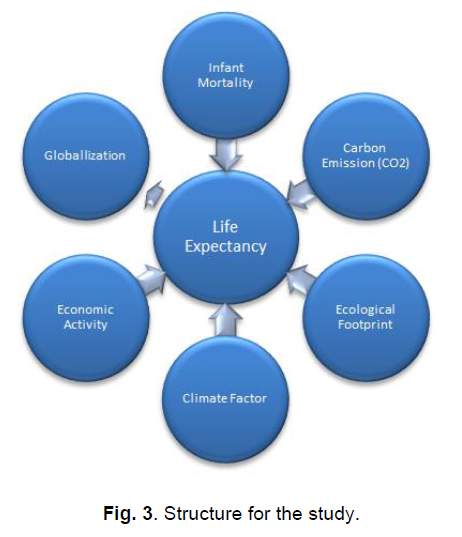
Fig 3. Structure for the study.
Stochastic equation
To fulfil the set objectives, this study forms the following stochastic equation used in the econometric analysis.
LEit=β0+β1 AVGTEMPit+β2STDTEMPit+β3GDPit+β4EFit+β5CO2it+β6MORit+β7GLOBit+μt
Here,
LE=Life Expetancy
AVG Temp: Average of Daily Temperature
STD Temp: Standard deviation of the daily temperature
GDP: Gross Domestic Product per capita
EF: Ecological Footprint
CO2: Carbon Emissions
MOR: Infant Mortality Rate
GLOB: Globalization
Unit root and cointegration test
As if the data has long time periods (t >20) than the implications of human error learning behavior becomes significant (Eberhardt, 2011; Pedroni, 2008), in such instance, the assumption of OLS will transgress, which explains that variables do not have constant mean and variance in time. Thus, this property will create the issue of autocorrelation in the data (Gujarati 2009). Furthermore, to check the existence of the above explained feature in panel data, we use panel unit root tests. For this purpose, the study has used, LLC (Levin et al., 2002), IPS (Im et al., 1997), ADF fisher and PP fisher (Maddala and Wu 1999; Fisher 1925).
The panel cointegration test examines the residuals, as a result of the model, which depicts that they significantly converge to zero. For this purpose, this study has used the Kao (1999) panel co-integration test. Considering that all of the variables are integrated of order 1, it is necessary that there must be a co-integration relationship between the proposed explanatory variables to get the valid estimates.
Estimation model
This study used the ‘panel FMOLS (Fully Modified Ordinary Least Square)’ model suggested by Hansen and Phillips (1990). It implements a semi-parametric correction to overcome the problems, which is influenced due to the long run relationships and also because of the co-integrating equation and stochastic repressor innovations. The resultant Panel FMOLS is comparably impartial and also it describes the fully efficient estimator (Pedroni, 2001).
Description of the variables
Table 1 describes the variables used in the study. Here, LE is used as a dependent variable and used as an indicator of human life longevity. Furthermore, temperature is used as a climate factor. The temperature data are monthly data that are then converted into yearly data. For estimation, we have used the average and standard deviation of temperature. Ecological Footprint, GDP, mortality rate, CO2, and globalization has also been used as independent variables. Table 1 describes the variables and data sources used in this study.
| Indicator | Symbol | Data Source | Descriptions |
|---|---|---|---|
| Life Expectancy (Dependent Variable) |
LE | WDI (2018) | LEXP at birth, explains the average time period expected to live |
| Environmental Factors (Temperature) |
TEMP | Global Historical Climatology Network | Temperature is used as an indicator of the climate |
| Gross Domestic Product | GDP | WDI (2018) | GDP is a value of all finished goods and services produced within a specific time period per person in US$ |
| Ecological Footprint | EF | Global Footprint Network | EF is the impact of a person or community on the environment expressed as the amount of land |
| Mortality rate | MOR | WDI (2018) | It is a measure of the number of infant deaths before 1st birthday in a particular population |
| Globalization | GLOB | KOF Globalization Index | Index representing how much a nation is globalized using de facto and de jure constructs |
| Carbon Emissions | CO2 | WDI (2018) | CO2 emissions in kt per capita |
Table 1. Data description.
Graphical associations
In the graphical associations, we can see that life expectancy positively correlates with an average temperature in Fig. 4, GDP in Fig. 6, CO2 in Fig. 8 and Globalization in Fig. 10. While it is negatively associated with temperature variation in Fig. 5, ecological footprint in Fig. 7 and mortality rate in Fig. 9.
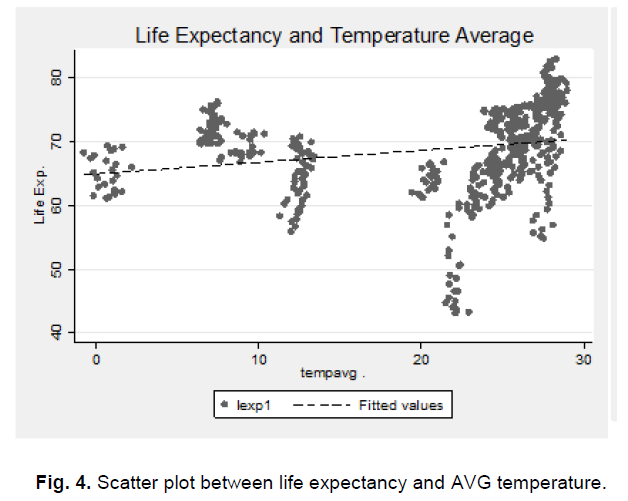
Fig 4. Scatter plot between life expectancy and AVG temperature.
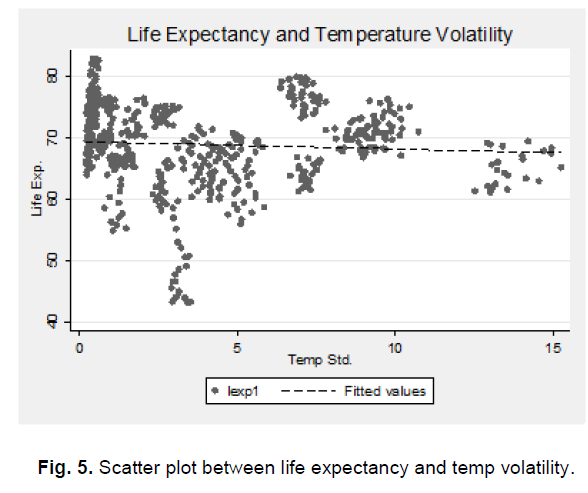
Fig 5. Scatter plot between life expectancy and temp volatility.
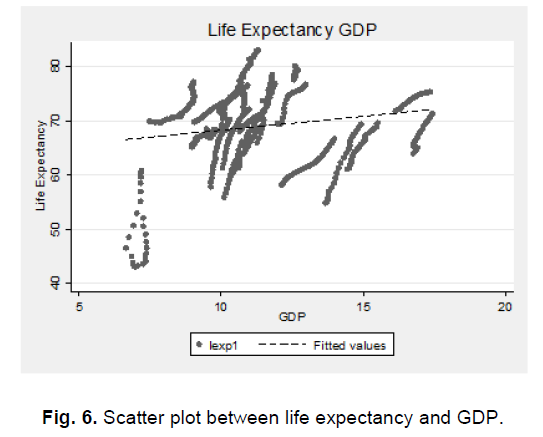
Fig 6. Scatter plot between life expectancy and GDP.
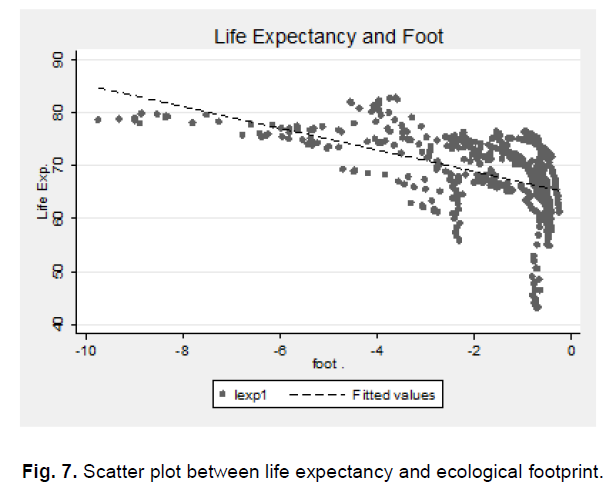
Fig 7. Scatter plot between life expectancy and ecological footprint.
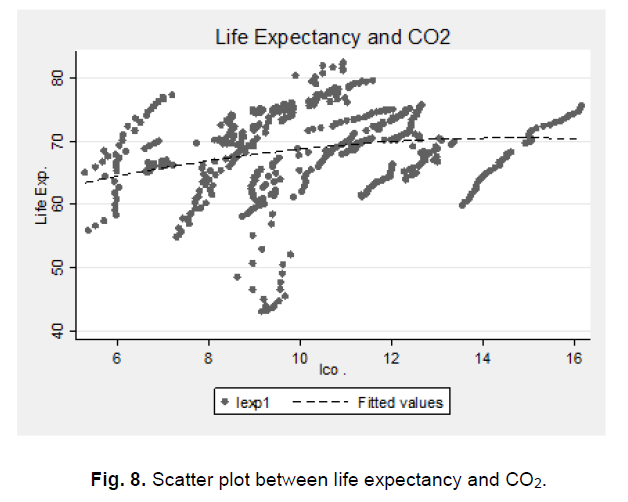
Fig 8. Scatter plot between life expectancy and CO2.
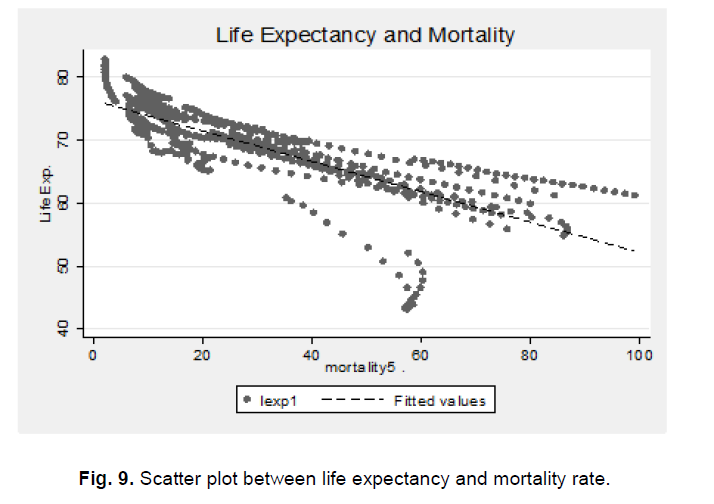
Fig 9. Scatter plot between life expectancy and mortality rate.
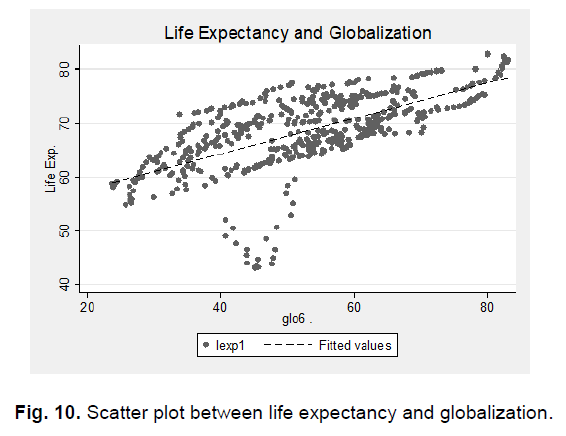
Fig 10. Scatter plot between life expectancy and globalization.
Table 2 expresses the results which show that most of the tests are insignificant at level and significant at first difference. Thus, it confirms that all of the variables are nonstationary at level and stationary at first difference, i.e., I (1), which means that the nature of variables is integrated of order 1.
| Table Panel Unit root results | |||||||
|---|---|---|---|---|---|---|---|
| Dependent Variable: Life Expectancy | |||||||
| Method | Level | First diff | |||||
| Statistic | Prob.** | Statistic | Prob.** | Order | Con | ||
| Temp AVG | Levin, Lin and Chu t* | 2.460 | 0.993 | -11.284 | 0.091 | I(1) | Stationary |
| Im, Pesaran and Shin W-stat | -6.285 | 0.00 | -18.783 | 0.00 | |||
| ADF - Fisher Chi-square | 122.19 | 0.00 | 362.90 | 0.00 | |||
| PP - Fisher Chi-square | 186.64 | 0.00 | 586.31 | 0.00 | |||
| Temp STD | Levin, Lin and Chu t* | 0.154 | 0.562 | -2.597 | 0.047 | I(1) | Stationary |
| Im, Pesaran and Shin W-stat | -9.677 | 0.00 | -18.142 | 0.00 | |||
| ADF - Fisher Chi-square | 183.99 | 0.00 | 350.12 | 0.00 | |||
| PP - Fisher Chi-square | 274.72 | 0.00 | 590.33 | 0.00 | |||
| LGDP | Levin, Lin and Chu t* | 0.2186 | 0.586 | -5.610 | 0.00 | I(1) | Stationary |
| Im, Pesaran and Shin W-stat | 6.934 | 1.000 | -10.260 | 0.00 | |||
| ADF - Fisher Chi-square | 22.644 | 0.999 | 195.56 | 0.00 | |||
| PP - Fisher Chi-square | 16.880 | 1.000 | 204.95 | 0.00 | |||
| EF | Levin, Lin and Chu t* | 2.953 | 0.998 | -14.395 | 0.00 | I(1) | Stationary |
| Im, Pesaran and Shin W-stat | 3.905 | 1.000 | -16.432 | 0.00 | |||
| ADF - Fisher Chi-square | 38.367 | 0.711 | 302.69 | 0.00 | |||
| PP - Fisher Chi-square | 37.376 | 0.749 | 345.59 | 0.00 | |||
| LCO2 | Levin, Lin and Chu t* | -1.417 | 0.782 | -13.449 | 0.00 | I(1) | Stationary |
| Im, Pesaran and Shin W-stat | 3.0695 | 0.998 | -16.010 | 0.00 | |||
| ADF - Fisher Chi-square | 27.636 | 0.991 | 321.50 | 0.00 | |||
| PP - Fisher Chi-square | 25.692 | 0.996 | 351.36 | 0.00 | |||
| MORT | Levin, Lin and Chu t* | -34.365 | 1.000 | -3.711 | 0.001 | I(1) | Stationary |
| Im, Pesaran and Shin W-stat | -37.081 | 0.00 | -3.360 | 0.004 | |||
| ADF - Fisher Chi-square | 1182.5 | 0.00 | 120.91 | 0.00 | |||
| PP - Fisher Chi-square | 1176.9 | 0.00 | 116.51 | 0.00 | |||
| GLOB | Levin, Lin and Chu t* | -7.3815 | 0.000 | -2.5207 | 0.059 | I(1) | Stationary |
| Im, Pesaran and Shin W-stat | -1.8303 | 0.336 | -6.8415 | 0.00 | |||
| ADF - Fisher Chi-square | 94.995 | 0.001 | 133.07 | 0.00 | |||
| PP - Fisher Chi-square | 99.417 | 0.00 | 241.42 | 0.00 | |||
Table 2. Unit root test of the panel.
Table 3 reveals the results of the test. According to this, the residuals of the model are significant at the 1% level, which confirms that there is a cointegration relationship in the model. The results of the test are based on AIC lag selection criteria.
| Test | t-statistic | Prob. | ||
|---|---|---|---|---|
| Kao residual Co-integration Test | ||||
| ADF | -3.04933 | 0.0011 | ||
Table 3. Panel co-integration test.
The results in Table 4 are generated from the FMOLS model. Here, all the proposed independent variables are jointly explaining 97.8% variation in the dependent variable. For the case of climate variables, increasing a 1% in temperature average and temperature standard deviation will lead to 0.33% and 0.29%% decrease is life expectancy. This shows how devastating global warming is to human life. There are several studies that confirmed such impact of temperature on human life. According to Anderson and Verner (2009), there is a negative and significant impact of temperature on the longevity of human life longevity. Their findings show that a slight increase in average environmental temperature will reduce the years of living. Another study shows that a slight rise in temperature will lead to an increase in severe heat and cold, which is harmful for human health and also for their life because it will give rise to several health problems such as strokes and asthma during rising levels of heat waves and cardiac muscle arrest during extreme cold (Salau, 2016; Zivin and Shrader, 2016).
| Independent Variables | Coefficient | Std. Error | T-stat | P-value |
|---|---|---|---|---|
| Fully modified least Squares (FMOLS) | ||||
| Dependent Variable: LEXP | ||||
| TEMPAVG | -0.33 | 0.06 | -4.71 | 0.00 |
| TEMPSTD | -0.29 | 0.07 | -3.81 | 0.02 |
| LGDP | 3.41 | 0.42 | 8.09 | 0.00 |
| LGDP*LGDP | -0.11 | 0.01 | -5.67 | 0.00 |
| EF | -0.18 | 0.07 | -2.52 | 0.01 |
| LCO2 | -0.25 | 0.11 | -2.24 | 0.02 |
| MORT | -0.18 | 0.04 | -41.59 | 0.01 |
| GLOB | 0.06 | 0.07 | 8.33 | 0.00 |
| R-Square | 0.9781 | |||
Table 4. Fully modified ordinary least squares (FMOLS).
Economic activity is a major ingredient in explaining human health outcomes. Here a 1% increase in GDP leads to an increase in life expectancy by 3.41% but with each percentage increase, the marginal effect reduces by 0.11%, thus following an inverted U-shaped relationship depicting diminishing returns in effects of human incomes on human life. As per the report of the World Bank (1998), per capita income is firmly related to the enhancement in life expectancy, and it has expected that a flourished economy has strong impacts on the life expectancy of its inhabitants. This means that if people in a flourished country have good incomes, they can spend more on the quality of their environment and make it healthy to live longer lives. Further, Ruhm (2000) stated that when the economy is on an upswing people will suffer more health-related problems and die faster, on the other hand when the economy falters people tend to live longer.
When economies are doing well and it grows faster than average, more people are dying. The main culprit behind this is pollution, which increases the mortality rates and reduces longevity. Emissions of greenhouse gases and due to industrial activities, air pollution and water pollution will increase and cause health-related problems. When economies growing particularly faster, pollution and emissions will also rise, but if governments can control these changes, then economic growth does not impact life expectancy (Muney, Cutler, and Huang, 2005).
By increasing the 1% level of ecological footprint, the longevity of human life longevity decreases by 0.18%. Therefore, when an individual uses an area of land to generate its waste material, the land turns into soil deterioration and land degradation that have a negative impact on the climate and thus reduce the human life longevity (Rosa et al., 2004; Xu et al., 2005; Dietz et al., 2007).
Emissions of greenhouse gases, for example CO2 and nitrous oxide due to human activities, will alter earth climate by causing high levels of temperature and other weather variations (IPPC 2007). Therefore, if carbon emissions (CO2) increases by 1%, the life-year expectancy will reduce by 0.25%. There are several studies that reveal that, people living in such countries that have low level of carbon emission can live a healthy life, as a high concentration of CO2 is harmful to human life longevity (Balan, 2016; Jerumeh et al., 2015; Ali and Ahmad, 2014).
Similarly, a 1% increase in mortality will decrease human life longevity by 0.18%. Therefore, if the health standard is poor, it definitely reduces the expected life.
Globalization has a significant and positive relationship with human life expectancy. If globalization increases by 1% than life expectancy will also increases by 0.06%. Globalization is a source of exchange of goods and knowledge that helps develop technology and integrate them into social and cultural systems. This consequently helps to benefit human life.
This study has used the Breusch Godfrey and Pegan (BGP) test for heteroscedasticity, DF equation method to test autocorrelation, and Jarque Bera test for normality. The results confirmed that there is no heteroskedasticity and autocorrelation while the model is asymptotic normal.
Conclusion
The study investigates the impact of economic, environmental and ecological factors on life expectancy among selected Asian countries for the period 1994-2017. We incorporate temperature as an indicator of climate, and the average and standard deviation of temperature are used for the estimation. Further explanatory variables, i.e. GDP, ecological footprint, CO2, mortality rate, and globalization are also used to analyze their impact on life expectancy. The data for temperature are extracted from Global Historical Climatology Network, for ecological footprint are from Global Footprint Network, and for Globalization from KOF Globalization Index. Data for other variables are extracted from World Development Indicator 2018. The study analyzed the effect of independent variables on the longevity of human life longevity with the expectation that each assessment will contribute to the literature.
By using Fully Modified Ordinary Least Square (FMOLS) the long-run coefficients are generated. The estimated results reveal that the ecological factors (temperature, CO2, ecological footprint) along with economic growth (GDP) at a high level and mortality have negative and significant impact on life expectancy while globalization has positive impact on human life longevity.
In addition, the research intends to see the effect of ecological factors on life expectancy. Temperature is an important component of climate. The rise in temperature due to the rise of industrial age increase severe heat and health problems such as strokes, dehydration, and cardiac vascular problems, reducing life expectancy and increasing the mortality ratio. Economic growth (GDP) also plays a vital role towards life expectancy, several studies show that when an economy grows faster people will suffer more health problems, it happens because, in the race of development, prosperity, and planting more industries governments did not pay attention that how it damages the environment and human health. The gases emitted through these industries pollute air and water, making it difficult for humans to breathe in such an environment. There is no doubt that human activities are particularly increasing the concentration of greenhouse gases, especially emissions of CO2, which is harmful for the human body. The increased levels of CO2 increase the risk of dying prematurely, as this greenhouse gas aggravates problems such as asthma or other lung diseases.
Policy Recommendations
An economy becomes more stable if there are better policies targeting the standard of living of individuals, by targeting the problems that damage the climate and ecosystem. The study recommends that despite immense achievements and despite having many positive policy efforts led by both governments and nongovernmental organizations, the selected Asian economies still face high climatic issues. So, much more needs to be done to overcome these environmental issues and work towards better health facilities without discrimination and a better political system.
The pressure on the ecosystem should be reduced by diversifying the sources of food and energy. Countries should come together to share the excess production so that the strain on land because of high-intensity cropping can be reduced. National policy should be devised to reduce the rate of increase in temperature and its variation. Definitely reducing CO2 emissions is the first target then to make economic activities ergonomic.
References
Amuka, J.I., Asogwa, F.O., Ugwuanyi, R.O., Omeje, A.N., Onyechi, T. (2018). Climate change and life expectancy in a developing country: Evidence from greenhouse gas (CO2) emission in Nigeria. International Journal of Economics and Financial Issues, 8:113-119
Arshed, N., Anwar, A., Hassan, M.S., Bukhari, S. (2019). Education stock and its implication for income inequality: The case of Asian economies. Review of Development Economics, 23:1050-1066.
Arshed, N., Mubashir, M., Mubashir, I. (2020). Sustainability assessment using STIRPAT approach to environmental quality: an extended panel data analysis. Environmental Science and Pollution Research, Early Print.
Ayres, R.U. (2000). Commentary on the utility of the ecological footprint concept. Ecological Economics, 3:347-349.
Blackburn, K., Cipriani, G.P. (2002). A model of longevity, fertility and growth. Journal of Economic Dynamics and Control, 26:187-204.
Bai, L., Ding, G., Gu, S., Bi, P., Su, B. (2014). The effects of summer temperature and heat waves on heat-related illness in a coastal city of China. Environmental Research, 32:209-212.
Berko, J., Ingram, D.D., Saha, S., Parker, J.D. (2014). Deaths attributed to heat, cold, and other weather events in the United States. National Health Statistical Report, 76:1-16.
Bhave, A.G., Conway, D., Dessai, S., Stainforth, D.A. (2016). Barriers and opportunities for robust decision making approaches to support climate change adaptation in the developing world. Journal of Environmental Economics, 18:825-837.
Becker, G.S., Philipson, T.J., Soares, R.R. (2003). The quantity and quality of life and the evolution of world inequality. American Economic Review, 95:277-291.
Bloom, D.E., Canning, D., Malaney, P. (2000). Demographic change and economic growth in Asia. Supply and Population Development Review, 26:90-257.
Bloom, D.E., Canning, D., Sevilla, J. (2004). The effect of health on economic growth: a production function approach. World Development Journal, 13:1-13.
Bagliani, M., Galli, A., Niccolucci, V., Marchettini, N. (2008). Ecological footprint analysis applied to a sub-national area: the case of the Province of Siena (Italy). Journal of Environmental Management, 86:354-364.
Bastianoni, S., Pulselli, F.M., Tiezzi, E. (2004). The problem of assigning responsibility for greenhouse gas emissions. Ecological Economics, 65:650-661.
Breitner, S., Wolf, K., Devlin, R.B., Sanchez, D., Peters, A., Schneider, A. (2014). Short-term effects of air temperature on mortality and effect modification by air pollution in three cities of Bavaria, Germany, a time-series analysis. International Journal of Environment, 485:49-61.
Burkart, K., Breitner, S., Schneider, A., Khan, M.H., Krämer, A., Endlicher, W. (2014). An analysis of heat effects in different subpopulations of Bangladesh. International Journal of Biometeorology, 58:82-775.
Coates, L., Haynes, K., O’Brien, J., McAneney, J., de Oliveira, F.D. (2014). Exploring 167 years of vulnerability: an examination of extreme heat events in Australia 1844–2010. Journal of Environmental Science, 42:33-44.
Cervellati, M., Sunde, U. (2011). Life expectancy and economic growth: the role of the demographic transition. Journal of Economic Growth, 16:99-133.
Coumou, D., Robinson, A. (2013). Historic and future increase in the global land area affected by monthly heat extremes. Environmental Research Center, 8:18-34.
Chen, M., Wang, R.S., Zhang, L.J., Xu, C.G. (2006). Temporal and spatial assessment of natural resource use in China using ecological footprint method. International Journal of Sustainable Development and World Ecology, 13:255-268.
Diboulo, E., Sie, A., Rocklöv, J., Niamba, L., Ye, M., Bagagnan, C., Sauerborn, R. (2012). Weather and mortality analysis of the Health and Demographic Surveillance System. Environmental Health Perspective, 119:205-213.
Donat, M.G., Alexander, L.V. (2012). The shifting probability distribution of global daytime and night‐time temperatures. The Global Environmental Research, 156:4-44.
Deaton, A. (2004). Health in an age of globalization. Brookings Trade Forum, pp:83-130.
Dietz, T., Rosa, E.A., York, R. (2007). Driving the human ecological footprint. Frontiers in Ecology and the Environment, 5:13-18.
Dietz, T., Rosa, E.A. (1994). Rethinking the environmental impacts of population, affluence and technology. Human Ecology Review, 1:277-300.
Egondi, T., Kyobutungi, C., Kovats, S., Muindi, K., Ettarh, R., Rocklöv, J. (2012). Time-series analysis of weather and mortality patterns in Nairobi’s informal settlements. Global Health Action, 5:82-775.
Elo, I.T., Preston, S.H. (1992). Effects of early-life conditions on adult mortality: a review. Population Index, 58:186-212.
Evans, M.F., Smith, V.K. (2005). Do new health conditions support mortality-air pollution effects? Journal of Environmental Economics and Management, 50:496-518.F
Erb, K.H. (2004). Actual land demand of Austria 1926–2000: a variation on ecological footprint assessments. Land Use Policy, 21:247-259.
Fuchs, V. (1996). Economics, values, and healthcare reform. American Economic Review, 86:1-24.
Granados, J.A.T., Ionides, E.L. (2008). The reversal of the relation between economic growth and health progress: Sweden in the 19th and 20th centuries. Journal of Health Economics, 27:544-563.
Holmberg, J., Lundqvist, U., Robèrt, K.H., Wackernagel, M. (1999). The ecological footprint from a systems perspective of sustainability. International Journal of Sustainable Development and World Ecology, 6:17-33.
Hansen, J., Sato, M., Ruedy, R. (2012). Perception of climate change. Environmental Impact Assessment Review, 26:377-395.
Huntingford, C., Jones, P.D., Livina, V.N., Lenton, T.M., Cox, P.M. (2013). No increase in global temperature variability despite changing regional patterns. Global Metrological Review, 55:251-276.
Im, K., Pesaran, M., Shin, Y. (2003). Testing for unit roots in heterogeneous panels. Econometrics Journal, 11:53-74.
Jouvet, P.A., Michel, P.H., Vidal, J.P. (2000). Intergenerational altruism and the environment. Scandinavian Journal of Economics, 102:135-150.
Kar, M., Taban, S. (2003). The impacts of the disaggregated public expenditure on economic growth. Ankara University Faculty of Political Science, 53:69-145.
Lleras, M., Cutler, D., Huang, W. (2005). Relationship between economic growth and life expectancy university of Harvard. National Bureau of Economic Research, 41:673-690.
Lucas, R. (1998). The mechanics of economic development. Journal of Economic Perspective, 22:3-42.
McMichael, A.J., Woodruff, R.E., Hales, S. (2006). Climate change and human health: present and future risks. The Lancet, 367:859-869.
Mankiw, G., Romer, D., Weil, D. (1992). A contribution on the Empirics of Economic Growth. Economic Journal, 17:37-407.
Ono, T., Maeda, Y. (2001). Is aging harmful to the environment. Environmental and Resource Economics, 20:113-127.
Pecchenino, R., John, A. (1994). An overlapping generation model of growth and the environment. Economic Journal, 104:1393-1410.
Pope, C.A., Bates, D.V., Raizenne, M.E. (1995). Health effects of particulate air pollution: time for reassessment. Environmental Health Perspective, 103:472-480.
Popp, D. (2001). Altruism and the demand for environmental quality. Land Economics, 77:339-349.
Patz, J.A., Lendrum, D., Holloway T., Foley, J.A. (2005). Impact of regional climate change on human health. Nature, 438:307-310.
Rahmstorf, S., Coumou, D. (2011). Increase of extreme events in a warming world USA. American Journal of Climate measures, 29:61-72.
Solow, R.A. (1956). A contribution to the theory of economic growth. Journal of Quantitative Economics, 70:65-94.
Shevchenko, O., Lee, H., Snizhko, S., Mayer, H. (2014). Long‐term analysis of heat waves in Ukraine. Journal of Asian Economics, 24:341-356.
Yumuşak, I.G., Yıldırım, C. (2009). An econometric examination over the relation between health expenditure and economic growth. Journal of Economics and Knowledge Management, 34:57-70.
Zanobetti, A., Nell, M.S., Gronlund, C.J., Schwartz, J.D. (2012). Summer temperature variability and long-term survival among elderly people with chronic disease. Proceedings of the National Academy of science of the United States of America, 109:6608-6613.
Zeng, W., Lao, X., Rutherford, S., Xu, Y., Xu, X., Lin, H., Chu, C. (2014). The effect of heat waves on mortality and effect modifiers in four communities of Guangdong Province, China. Science of the Total Environment, 482:214-221.
Author Info
R. Fatima1, N. Arshed1* and U. Hanif22Forman Christian College University, Lahore, Pakistan
Citation: Fatima, R., Arshed, N., Hanif, U. (2021). Do ecological factors dictate human life longevity? A case of Asian countries. Ukrainian Journal of Ecology 11 (8), 1-12.
Received: 30-Apr-2021 Accepted: 08-Oct-2021 Published: 23-Oct-2021
Copyright: This is an open access article distributed under the terms of the Creative Commons Attribution License, which permits unrestricted use, distribution, and reproduction in any medium, provided the original work is properly cited.
